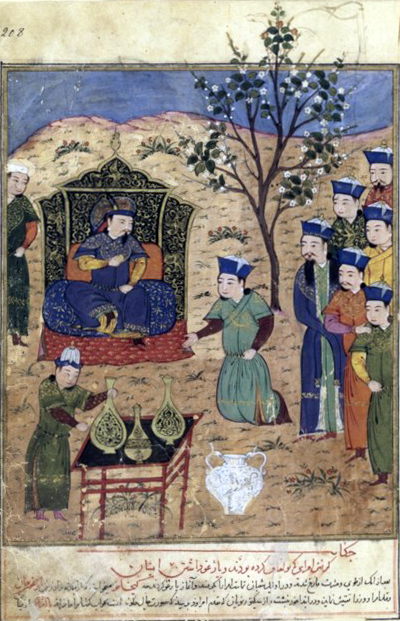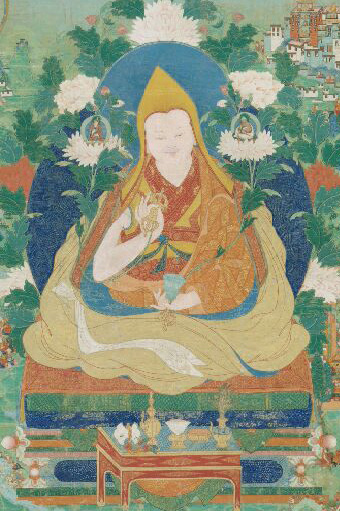|
Bogd Khan Uul
The Bogd Khan Mountain ( Mongolian: Богд хан уул, ''lit. "Saint Khan Mountain"'') is a mountain in Mongolia that overlooks the nation's capital, Ulaanbaatar, from a height of to the south of the city. World Heritage Status The Bogd Khan Mountain, along with Mongolia's other sacred mountains Burkhan Khaldun and Otgontenger, was added to the UNESCO World Heritage Tentative List on August 6, 1996 in the Cultural category. World Heritage sites are those that exhibit universal natural or cultural significance, or both. In 1783 the local Mongolian government of the Qing dynasty declared the Bogd Khan a protected site, for its beauty. Protection in 1681 and Zanabazar's two pavilions Mount Bogd Khan Uul was already protected during Zanabazar's time. Zanabazar was said to have meditated under a tree called Janchivsembe in Nukht Valley of Mount Bogd Khan Uul. Russian envoy V.S.Turskii, the son of a Tobolsk landowner, was sent to the 1st Jebtsundamba Khutugtu Zanabazar (1 ... [...More Info...] [...Related Items...] OR: [Wikipedia] [Google] [Baidu] |
Ulaanbaatar
Ulaanbaatar (; mn, Улаанбаатар, , "Red Hero"), previously anglicized as Ulan Bator, is the capital and most populous city of Mongolia. It is the coldest capital city in the world, on average. The municipality is located in north central Mongolia at an elevation of about in a valley on the Tuul River. The city was originally founded in 1639 as a nomadic Buddhist monastic center, changing location 28 times, and was permanently settled at its current location in 1778. During its early years, as Örgöö (anglicized as Urga), it became Mongolia's preeminent religious center and seat of the Jebtsundamba Khutuktu, the spiritual head of the Gelug lineage of Tibetan Buddhism in Mongolia. Following the regulation of Qing-Russian trade by the Treaty of Kyakhta in 1727, a caravan route between Beijing and Kyakhta opened up, along which the city was eventually settled. With the collapse of the Qing Empire in 1911, the city was a focal point for independence efforts, leading ... [...More Info...] [...Related Items...] OR: [Wikipedia] [Google] [Baidu] |
Mountains Of Mongolia
A mountain is an elevated portion of the Earth's crust, generally with steep sides that show significant exposed bedrock. Although definitions vary, a mountain may differ from a plateau in having a limited summit area, and is usually higher than a hill, typically rising at least 300 metres (1,000 feet) above the surrounding land. A few mountains are isolated summits, but most occur in mountain ranges. Mountains are formed through tectonic forces, erosion, or volcanism, which act on time scales of up to tens of millions of years. Once mountain building ceases, mountains are slowly leveled through the action of weathering, through slumping and other forms of mass wasting, as well as through erosion by rivers and glaciers. High elevations on mountains produce colder climates than at sea level at similar latitude. These colder climates strongly affect the ecosystems of mountains: different elevations have different plants and animals. Because of the less hospitable terrain and ... [...More Info...] [...Related Items...] OR: [Wikipedia] [Google] [Baidu] |
Manjusri Monastery
Mañjuśrī Monastery ( mn, Манзуширын хийд; alternately translated as Manzushir; ) is a former gompa established in 1733 and destroyed by Mongolian communists in 1937. Its ruins are located approximately 15 kilometers (as the crow flies, 43 kilometers by car) south of the Mongolian capital Ulaanbaatar on the south slope of Bogd Khan Mountain. History The monastery, dedicated to Mañjuśrī, the Bodhisattva of wisdom, was first established by the sainted monk Luvsanjambaldanzan in 1733 as the permanent residence of the Reincarnation of the Bodhisattva of Wisdom. It came under the personal administration of Mongolia’s religious leader, the Jebtsundamba Khutuktu, also known as the Bogd Khan, in 1750. Over time, the expanded monastery became one of the country's largest and most important monastic centers comprising 20 temples and housing more than 300 monks. Religious ceremonies often involved more than 1000 monks. The lamasery housed a collection of valuable and ... [...More Info...] [...Related Items...] OR: [Wikipedia] [Google] [Baidu] |
Noyans
''Noyan'' (pl. noyad), or ''Toyon'', was a Central Asian title of authority which was used to refer to civil-military leaders of noble ancestry in the Central Asian Turkic Khanates with origins in ''Noyon'', which was used as a title of authority in the Chagatai Khanate of the Mongol Empire. In modern times, Noyan is used as a given name or surname in Turkey and throughout Central Asia meaning "the lord", "the prince", "the protector", "the commander-in-chief". Pre-Genghisid period Initially, Noyan was a title for chieftains of Mongolian nomad communities. Mongol Empire and successor states Under Genghis Khan the term "''Noyon"'' applied to leaders of '' Tumens'' and ''Mingghans'', social-military units of 10,000 and 1,000 households respectively, each of them with one recruitable soldier. In times of peace the ''Noyons'' ruled as lords over these households and governed the use of the pasture lands. In times of war they leaded the warriors of their Tumens and Mingghans. Du ... [...More Info...] [...Related Items...] OR: [Wikipedia] [Google] [Baidu] |
Imperial Household Department
The Imperial Household Department (; mnc, , v=dorgi baita be uheri kadalara yamun) was an institution of the Qing dynasty of China. Its primary purpose was to manage the internal affairs of the Qing imperial family and the activities of the inner palace (in which tasks it largely replaced eunuchs), but it also played an important role in Qing relations with Tibet and Mongolia, engaged in trading activities (jade, ginseng, salt, furs, etc.), managed textile factories in the Jiangnan region, and even published books. This department was also in charge of the ceremonial and spiritual activities of the Qing imperial household. These activities include the maintenance of the mausoleums of Qing emperors, polytheist worships and posthumous affairs of the royal family (the giving of temple names and posthumous names). Origins The department was established before the Manchu-led Qing dynasty defeated the Ming dynasty in 1644, but it became mature only after 1661, following the death of ... [...More Info...] [...Related Items...] OR: [Wikipedia] [Google] [Baidu] |
Lifan Yuan
The Lifan Yuan (; ; Mongolian: Гадаад Монголын төрийг засах явдлын яам, ''γadaγadu mongγul un törü-yi jasaqu yabudal-un yamun'') was an agency in the government of the Qing dynasty of China which administered the empire's Inner Asian territories such as Mongolia and oversaw the appointments of Ambans in Tibet. Until the 1860s, it was also responsible for the Qing's relations with the Russian Empire. Name The name Lifan Yuan has various translations in English, including the ''Board for National Minority Affairs'', ''Court of Territorial Affairs'', ''Board for the Administration of Outlying Regions'', ''Office for Relations with Principalities'', ''Office of Barbarian Control'', ''Office of Mongolian and Tibetan Affairs'' and ''Court of Colonial Affairs''. etc. The office was initially known as the Mongol Yamen (; , lit. the Mongol department) when it was first created in 1636. In 1639 the department was renamed and expanded to "Lifan Yuan" in ... [...More Info...] [...Related Items...] OR: [Wikipedia] [Google] [Baidu] |
Zanabazar
Öndör Gegeen Zanabazar, , , "High Saint Zanabazar"; 1635–1723 (born Eshidorji) was the sixteenth '' Jebtsundamba Khutuktu'' and the first ''Bogd Gegeen'' or supreme spiritual authority, of the Gelugpa (Yellow Hat) lineage of Tibetan Buddhism in Mongolia. The son of a Mongol Tüsheet Khan, Zanabazar was declared spiritual leader of Khalkha Mongols by a convocation of nobles in 1639 when he was just four years old. The 5th Dalai Lama (1617–1682) later recognized him as the reincarnation of the Buddhist scholar Taranatha and bestowed on him the Sanskrit name ''Jñānavajra'' (Sanskrit: ज्ञानवज्र, ''Zanabazar'' in Mongolian) meaning "thunderbolt scepter of wisdom". Over the course of nearly 60 years, Zanabazar advanced the Gelugpa school of Buddhism among the Mongols, supplanting or synthesizing Sakya or " Red Hat" Buddhist traditions that had prevailed in the area, while strongly influencing social and political developments in 17th century Mongolia. His clos ... [...More Info...] [...Related Items...] OR: [Wikipedia] [Google] [Baidu] |
Jebtsundamba Khutuktu
The Jebtsundamba Khutuktu, , ; zh, c=哲布尊丹巴呼圖克圖, p=Zhébùzūn Dānbā Hūtúkètú; bo, རྗེ་བཙུན་དམ་པ་ཧུ་ཐུག་ཐུ་, Jetsün Dampa Hutuktu; "Venerable Excellent incarnate lama" are the spiritual heads of the Gelug lineage of Tibetan Buddhism in Mongolia. They also hold the title of ''Bogd Gegeen'', making them the top-ranked lamas in Mongolia. History The first Jebtsundamba, Zanabazar (1635–1723), was identified as the reincarnation of the scholar Taranatha of the Jonang school of Tibetan Buddhism. Zanabazar was the son of the Tüsheet Khan Gombodorj, ruler of central Khalkha Mongolia, and himself became the spiritual head of the Khalkha Mongols. On May 29, the Jebtsundamba Khutukhtu paid homage to the Kangxi Emperor in 1691 at Dolonnor. Like Zanabazar, the 2nd Jebtsundamba Khutughtu was a member of Mongolia's highest nobility and direct descendant of Genghis Khan. After Chingünjav's rebellion and the demis ... [...More Info...] [...Related Items...] OR: [Wikipedia] [Google] [Baidu] |
Khalkha
The Khalkha (Mongolian script, Mongolian: mn, Халх, Halh, , zh, 喀爾喀) have been the largest subgroup of Mongols, Mongol people in modern Mongolia since the 15th century. The Khalkha, together with Chahars, Ordos Mongols, Ordos and Tumed, were directly ruled by Borjigin khans until the 20th century; unlike the Oirats, who were ruled by Dzungar people, Dzungar nobles or the Khorchin Mongols, Khorchins, who were ruled by Qasar's descendants. The two original major Khalkha groups were ruled by the direct male line descendants of Dayan Khan. The Baarin, Khongirad, Jaruud, Bayads, Bayaud and the O'zeed (Ujeed) became Dayan Khan's fifth son Achibolod's subjects, thus formed the Southern Five Halhs. Seven northern Khalkha otogs: 1) Jalairs, Olkhonud; 2) Besut, Iljigin; 3) Gorlos, Keregut; 4) Khuree, Khoroo, Tsookhor; 5) Khukhuid, Khatagin; 6) Tangut people, Tanghut, Sartuul; 7) Uriankhai became Dayan Khan's youngest (could be third) son Geresenje's ( mn, Гэрсэне Жал� ... [...More Info...] [...Related Items...] OR: [Wikipedia] [Google] [Baidu] |
Qianlong Emperor
The Qianlong Emperor (25 September 17117 February 1799), also known by his temple name Emperor Gaozong of Qing, born Hongli, was the fifth Emperor of the Qing dynasty and the fourth Qing emperor to rule over China proper, reigning from 1735 to 1796. The fourth son of the Yongzheng Emperor, he reigned officially from 11 October 1735 to 8 February 1796. In 1796, he abdicated in favour of his son, the Jiaqing Emperor, out of filial piety towards his grandfather, the Kangxi Emperor, who ruled for 61 years, so that he not officially usurp him as the longest-reigning emperor. Despite his retirement, however, the Qianlong Emperor retained ultimate power as the Emperor Emeritus until his death in 1799, making him one of the longest-reigning monarchs in history, and dying at the age of 87, one of the longest-lived. As a capable and cultured ruler inheriting a thriving empire, during his long reign, the Qing Empire reached its most splendid and prosperous era, boasting a large popul ... [...More Info...] [...Related Items...] OR: [Wikipedia] [Google] [Baidu] |
Qing Dynasty
The Qing dynasty ( ), officially the Great Qing,, was a Manchu-led imperial dynasty of China and the last orthodox dynasty in Chinese history. It emerged from the Later Jin dynasty founded by the Jianzhou Jurchens, a Tungusic-speaking ethnic group who unified other Jurchen tribes to form a new "Manchu" ethnic identity. The dynasty was officially proclaimed in 1636 in Manchuria (modern-day Northeast China and Outer Manchuria). It seized control of Beijing in 1644, then later expanded its rule over the whole of China proper and Taiwan, and finally expanded into Inner Asia. The dynasty lasted until 1912 when it was overthrown in the Xinhai Revolution. In orthodox Chinese historiography, the Qing dynasty was preceded by the Ming dynasty and succeeded by the Republic of China. The multiethnic Qing dynasty lasted for almost three centuries and assembled the territorial base for modern China. It was the largest imperial dynasty in the history of China and in 1790 the f ... [...More Info...] [...Related Items...] OR: [Wikipedia] [Google] [Baidu] |







